Myasishchev M-53. Supersonic passenger
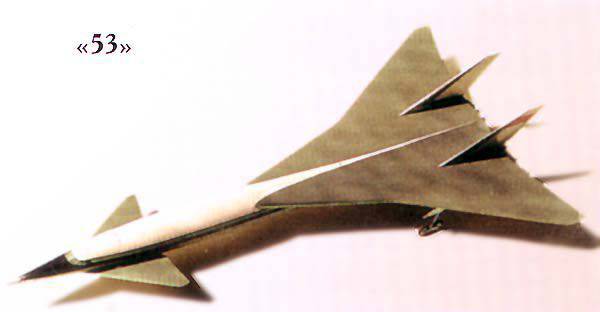
The rapid development of the world economy in the 50-s of the last century required the expansion and streamlining of relations between remote regions. Since 1958, regular passenger transatlantic flights of Boeing-707 long-range jet liners between the USA and Europe open up.
Firstborn reactive civil aviation had a cruising flight speed of about 800 km / h. A steady upward trend in the speed of air transport made the transition to supersonic speeds inevitable. Given this and drawing on the experience of creating the supersonic strategic bombers M-50 and M-52, OKB-23 for the first time in the USSR in 1958 began design studies on a supersonic passenger aircraft (ATP).
A weighty reason for this initiative was, in all likelihood, the realization of V.M. Myasishchev of the fact that the supersonic M-50, M-52 and M-56 will remain in the discharge of the experienced, although the first of them successfully passed the flight tests. The indifferent and even biased attitude of the military-political leadership to the developments of OKB-23 was also felt during the visit of the party and government delegation headed by N.S. Khrushchev, at the enterprise in August 1958 of the year and during the work of the mock-up commission for M-52 in May-June 1959 of the year.
Bomber M-50.
The development of the ATP was an attempt to use the unique experience of developing long-range supersonic aircraft in a new civil aviation field for the OKB. The ATP project received the cipher "55". In 1958, we considered four versions of the aircraft, differing in dimension and aerodynamic configuration. Among them are three options made according to the "duck" scheme.
The first of them "55А", with a delta wing and two TRN М16-17П, was calculated on transportation of passengers to 60 for the distance to 2500 km. The design of the aircraft "55B", with a triple sweep wing and four TRD M16-17P, accommodated up to 110 passengers and had a range of up to 6000 km. The “55B” variant, with a delta wing and six TRD VK-15М, could carry up to 120 passengers for a distance of 6500 km. The “55D” project had a classic scheme, reminiscent of M-50А with a delta wing and four TRD М16-17П. It contained up to 110 passengers, and the range reached 5500 km.
Estimated cruising flight speed of options "A", "B" and "D" was 2000 km / h, option "B" - 2600 km / h. In 1959, the work on ATP continued. At the first stage, the development of a passenger modification of the M-50A bomber was assumed, at the second stage, a new liner with a speed corresponding to the number M = 3 was assumed. The project first received the cipher "53", the second - "59". Later, only the “53” cipher was used, since the “59” cipher was obtained by a supersonic strategic system with turbo-propulsion engines.
The leading designer on the topic was appointed VG Grigoriev, and the project "53" - V.M. Maximov. The leadership of the Civil Air Fleet supported this initiative and issued preliminary requirements for the ATP. At the end of 1959, the corresponding decree of the USSR Council of Ministers was issued. At the same time, at the suggestion of the Civil Air Fleet, the design of the M-29 passenger aircraft based on the ZM bomber, which was discontinued in 1955, was accepted for consideration.
The main attention was paid to the choice and justification of the characteristics and the ATP scheme. When choosing the look of ATP in the Design Bureau, the following considerations were guided.
The selected layout was supposed to ensure first of all the highest aerodynamic quality on the cruise flight mode and the greatest weight return for the fuel. In addition, it was necessary to “soften” the jump-like displacement of the aerodynamic focus when passing through the sound barrier. When choosing the ATP scheme, it was required to provide maximum comfort to passengers, low noise level in the cabin, fire safety of the aircraft during emergency landings and acceptable take-off and landing characteristics.
Four possible ATP configurations of the same dimension were considered: M-53А - normal scheme with a delta wing and tail assembly with engines mounted on pylons under the wing (of the M-50А type); M-53B - according to the "duck" scheme with engines on pylons under the wing; M-53В - according to the "duck" scheme with bearing wing nacelles and M-53Г - "duck" with the package arrangement of engines in the rear part of the fuselage.
The classical scheme of the aircraft had certain advantages, the main of which was its development, which made it possible to create an ATP in the shortest possible time, but its aerodynamic quality at supersonic is low. In addition, when switching to supersonic flight regimes, the aerodynamic focus shifted sharply. Because of this, to ensure the centering of the aircraft, it was necessary to place part of the fuel in the front compartments of the fuselage and apply its transfer system in flight to the tail part of the fuselage.
This required the use of automatic centering and longitudinal stability, which complicated the aircraft and reduced its safety. In addition, due to the low aerodynamic quality and low weight impact on fuel, the classical scheme did not provide the required flight range.
The noted deficiencies were largely eliminated when choosing the aerodynamic "duck" with a variable sweep wing and a "floating" front tail. For aircraft of this scheme, the displacement of the aerodynamic focus during the transition to supersonic flight regimes was reduced to a minimum, which made it possible to do without pumping fuel.
In addition, the large root chord of the wing allowed to increase the building height and reduce its weight, which, together with other technical solutions, reduced the load and increased the weight of the aircraft on fuel. These main advantages of the "duck" were decisive, despite the worst aerodynamics at subsonic speeds and reduced take-off and landing characteristics. As for the comparison of the three considered variants of the “duck” scheme among themselves, they boiled down to the following: installation of engines on pylons reduces aerodynamic quality in cruise flight mode; The installation of engines in supporting nacelles “pack” in a common nacelle gives higher quality values than in the previous layout.
Studies have shown that the most acceptable is the package arrangement of engines. This reduced the noise level in the cabin, made it easier to parry the moments of roll and slip when part of the engines failed to fly. However, due to the novelty of this scheme, a more in-depth study was required. It should be noted that the basis of the schematic solution M-53 was based on the results of research on the appearance of the reconnaissance bomber M-56Р.
The engines for ATP, in particular, should have been equipped with devices for reverse thrust, noise suppression and have a resource of at least 1000 hours with a minimum ratio of weight and take-off thrust. These requirements were met to a certain extent by formless turbofan engines. Ready engines, as always, was not. We took into consideration the serial VD-7K, РД16-17 (chief designer PF Tine), created for M-52 and M-56, and the design project of the turbofan VK-15 by OKB-11 7 V.Ya. Klimov, also planned for use in the power plant of the reconnaissance bomber M-56P.
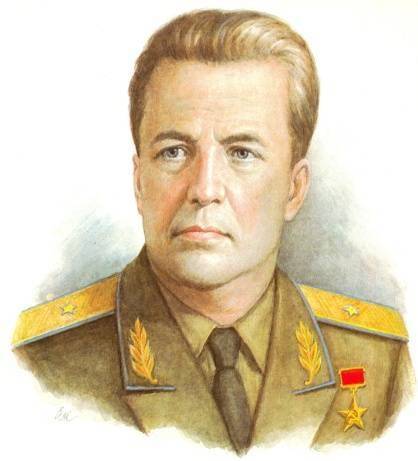
Much attention was paid to the choice and justification of cruising speed. The ATP should not carry out the entire flight at supersonic speed, since shock waves created at a low altitude cause sharp pulses of pressure on the surface of the earth, leading to destruction or damage to buildings and structures. Therefore, flights with supersonic speeds were planned at altitudes above 10000 m.
Thus, part of the path traveled by an aircraft must be spent on climb, to accelerate to supersonic speed, and to brake before lowering. The smaller the range, the greater the proportion of the path accounted for in the subsonic stages of flight and the less the advantage of high speed cruising flight.
On this basis, they concluded that for the ATP with a range of 4500 km, the cruising speed should not exceed the number M = 2, and for the range of 6500 km, more than three times the sound speed. Given the cruise range and payload, the cruising speed was chosen from the condition of the lowest cost of transportation. At a distance of 4500 km, the most favorable was the speed corresponding to the number M = 1,9-2,1. In addition, the choice of speed was significantly influenced by the performance of structural materials with intensive aerodynamic heating and a change in the characteristics of the engines, depending on the number "M".
At the first stage of creating the ATP, it was decided to maximize the experience of building subsonic airplanes using rotary turbofan engines and standard designs made of D-16 and B-95 aluminum alloys, the strength characteristics of which are maintained to temperatures that occur during flight at a speed corresponding to M = 2- 2,2. Otherwise, it would be necessary to apply heat-resistant steels and titanium alloys, the structures of which have not yet been worked out.
As a result, it was concluded that the optimal cruising speed of an aircraft with a range of 4500 km should correspond to the numbers M = 1,8-2. As a result, a significant economic effect was achieved as a result of reducing the cost of the aircraft fleet for a given volume of air traffic, the time spent by passengers and flight personnel and service personnel were reduced.
The cost of transporting tons of cargo per kilometer in 1960 prices for an aircraft of a normal scheme did not exceed 2,2 rubles, for ducks with engines on pylons — 2,16 rubles, and with bearing nacelles or packaged engines — 2,14 rubles.
As a result of the study of the possible appearance of a promising ATP, they came to the conclusion that the requirements of the civil airframe (especially in range) can only be met with aerodynamic quality not lower than 6, the weight impact on the fuel is 48-55% and the engine has high specific characteristics.
High aerodynamic quality was achieved only with the use of fundamentally new aerodynamic schemes and engine layout. In particular, “duck” schemes with floating tail, variable sweep wing and engine package under the wing or in the form of engine nacelles.
None of the engines built and developed at that time met the requirements set for it. On the basis of layout, design and layout studies, together with the Civil Air Fleet, they clarified the draft requirements for the ATP.
They built two partial models of the aircraft with passenger compartments with a diameter of 3,2 m and a length of 9 m, a buffet-kitchen with a diameter of 3,2 m and a length of 2,5 m.
The models were designed to determine the minimum diameter of the fuselage when placed in a row of six passenger seats, determine the optimal size of the passenger seat and utility rooms, rational placement of the equipment of the buffet and kitchen based on 120 passengers, the choice of lighting, ventilation and exterior design.
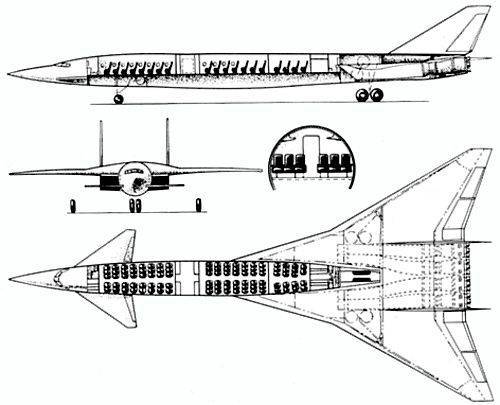
In pursuance of the May 1960, government decrees in August submitted to the SCCAT an 100-130 local project MPS "M-53" with a cruising speed of 1800-2000 km / h and a range of up to 6500 km. Two months later, OKB-23 ceased to exist, and after another three years, OKB-51 A.N. Tupolev began to design the ATP Tu-144. It should be noted that most of the soon-built long-range supersonic military or civilian aircraft used a variable sweep wing, controlled by the landing light and the "package" placement of engines. Only the Tu-144 had the tailless scheme, but on the serial samples the forward horizontal tail appeared on the take-off and landing.
For the first time in the USSR, OKB-23 specialists encountered difficulties associated with a supersonic long flight, and were able to make recommendations for overcoming them. In addition, the dimension of the ATP and its main flight performance, predicted in OKB-23, were implemented in the mentioned machines, which makes honor to the designers of OKB-23 as the pioneers of supersonic long-range aviation.
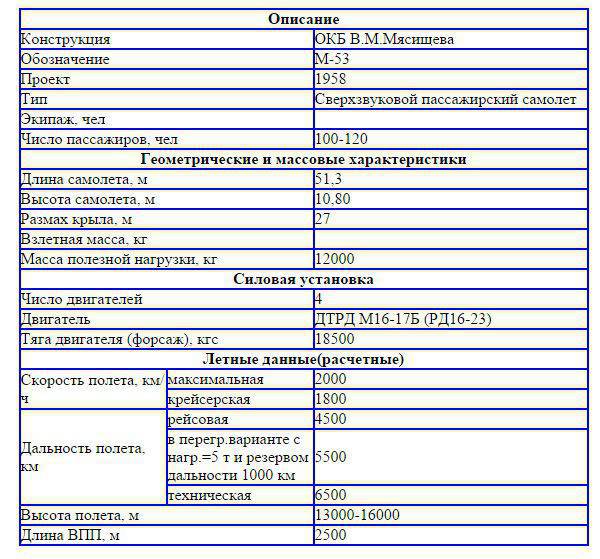
Sources:
Lavrov V., Yakubovich N. Planes V.M. Myasishchev. M .: Rusavia, 1999. C. 144, 149.
Artemyev A. Wings of a superpower. M .: Yauza, Eksmo, 2009. C. 222-225.
Ilyin V., Levin M. Bombers. T.2. M .: Victoria, AST, 1996. C. 24-26.
Sovenko A. M-50: getting rid of illusions // Aviation and time. 2005. No.1. C. 13, 16.
Brooke A. Smirnov S. Supersonic passenger aircraft // Wings of the Motherland. 2002. No.7. C. 6-7.
Smirnov K. History Lost Victory // Aviahrad Zhukovsky Newspaper. 2014. 21 October.
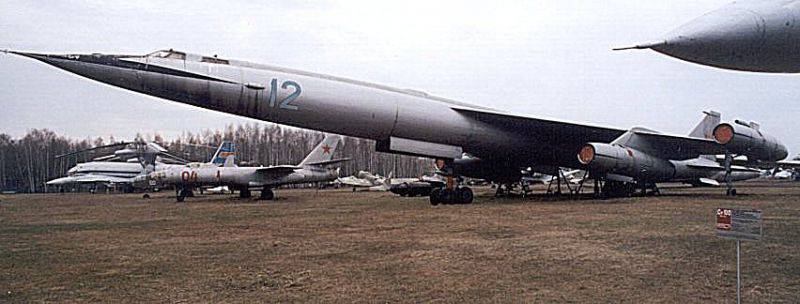
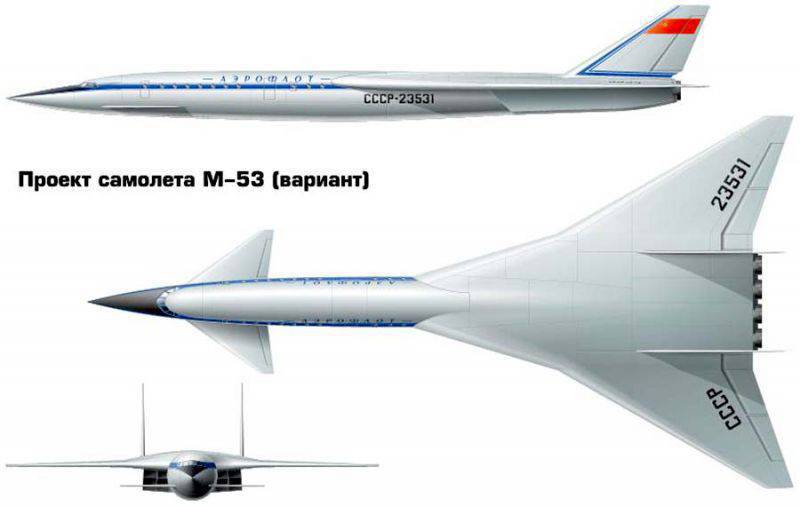
Information